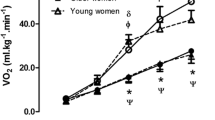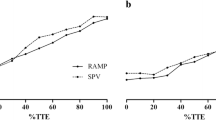Abstract
Although aging is typically associated with a decline in maximal oxygen consumption (VO2max), young and old subjects, of similar initial muscle metabolic capacity, increased quadriceps VO2max equally when this small muscle mass was trained in isolation. As it is unclear if this preserved exercise-induced plasticity with age is still evident with centrally challenging whole body exercise, we assessed maximal exercise responses in 13 young (24 ± 2 years) and 13 old (60 ± 3 years) males, matched for cycling VO2max (3.82 ± 0.66 and 3.69 ± 0.30 L min−1, respectively), both before and after 8 weeks of high aerobic intensity cycle exercise training. As a consequence of the training both young and old significantly improved VO2max (13 ± 6 vs. 6 ± 7 %) and maximal power output (20 ± 6 vs. 10 ± 6 %, respectively) from baseline, however, the young exhibited a significantly larger increase than the old. Similarly, independently assessed maximal cardiac output (Q max) tended to increase more in the young (16 ± 14 %) than in the old (11 ± 12 %), with no change in a-vO2 difference in either group. Further examination of the components of Q max provided additional evidence of reduced exercise-induced plasticity in both maximal heart rate (young −3 %, old 0 %) and stroke volume (young 19 ± 15, old 11 ± 11 %) in the old. In combination, these findings imply that limited central cardiovascular plasticity may be responsible, at least in part, for the attenuated response to whole body exercise training with increasing age.


Similar content being viewed by others
References
Coggan AR, Spina RJ, King DS, Rogers MA, Brown M, Nemeth PM, Holloszy JO (1992) Skeletal muscle adaptations to endurance training in 60- to 70-yr-old men and women. J Appl Physiol 72(5):1780–1786
Dibski DW, Smith DJ, Jensen R, Norris SR, Ford GT (2005) Comparison and reliability of two non-invasive acetylene uptake techniques for the measurement of cardiac output. Eur J Appl Physiol 94(5–6):670–680. doi:10.1007/s00421-005-1343-2
Ehsani AA, Ogawa T, Miller TR, Spina RJ, Jilka SM (1991) Exercise training improves left ventricular systolic function in older men. Circulation 83(1):96–103
Ehsani AA, Spina RJ, Peterson LR, Rinder MR, Glover KL, Villareal DT, Binder EF, Holloszy JO (2003) Attenuation of cardiovascular adaptations to exercise in frail octogenarians. J Appl Physiol 95(5):1781–1788. doi:10.1152/japplphysiol.00194.2003
Faulkner JA, Davis CS, Mendias CL, Brooks SV (2008) The aging of elite male athletes: age-related changes in performance and skeletal muscle structure and function. Clin J Sport Med 18(6):501–507. doi:10.1097/JSM.0b013e3181845f1c
Fleg JL, Morrell CH, Bos AG, Brant LJ, Talbot LA, Wright JG, Lakatta EG (2005) Accelerated longitudinal decline of aerobic capacity in healthy older adults. Circulation 112(5):674–682. doi:10.1161/CIRCULATIONAHA.105.545459
Fujimoto N, Prasad A, Hastings JL, Arbab-Zadeh A, Bhella PS, Shibata S, Palmer D, Levine BD (2010) Cardiovascular effects of 1 year of progressive and vigorous exercise training in previously sedentary individuals older than 65 years of age. Circulation 122(18):1797–1805. doi:10.1161/CIRCULATIONAHA.110.973784
Gleser MA (1973) Effects of hypoxia and physical training on hemodynamic adjustments to one-legged exercise. J Appl Physiol 34(5):655–659
Grimby G, Nilsson NJ, Saltin B (1966) Cardiac output during submaximal and maximal exercise in active middle-aged athletes. J Appl Physiol 21(4):1150–1156
Grimsmo J, Arnesen H, Maehlum S (2010) Changes in cardiorespiratory function in different groups of former and still active male cross-country skiers: a 28–30-year follow-up study. Scand J Med Sci Sports 20(1):e151–e161. doi:10.1111/j.1600-0838.2009.00931.x
Hagberg JM, Allen WK, Seals DR, Hurley BF, Ehsani AA, Holloszy JO (1985) A hemodynamic comparison of young and older endurance athletes during exercise. J Appl Physiol 58(6):2041–2046
Harber MP, Konopka AR, Undem MK, Hinkley JM, Minchev K, Kaminsky LA, Trappe TA, Trappe S (2012) Aerobic exercise training induces skeletal muscle hypertrophy and age-dependent adaptations in myofiber function in young and older men. J Appl Physiol 113(9):1495–1504. doi:10.1152/japplphysiol.00786.2012
Hawkins S, Wiswell R (2003) Rate and mechanism of maximal oxygen consumption decline with aging: implications for exercise training. Sports Med 33(12):877–888
Heath GW, Hagberg JM, Ehsani AA, Holloszy JO (1981) A physiological comparison of young and older endurance athletes. J Appl Physiol 51(3):634–640
Helgerud J (1994) Maximal oxygen uptake, anaerobic threshold and running economy in women and men with similar performances level in marathons. Eur J Appl Physiol Occup Physiol 68(2):155–161
Helgerud J, Hoydal K, Wang E, Karlsen T, Berg P, Bjerkaas M, Simonsen T, Helgesen C, Hjorth N, Bach R, Hoff J (2007) Aerobic high-intensity intervals improve VO2max more than moderate training. Med Sci Sports Exerc 39(4):665–671. doi:10.1249/mss.0b013e3180304570
Helgerud J, Karlsen T, Kim WY, Hoydal KL, Stoylen A, Pedersen H, Brix L, Ringgaard S, Kvaerness J, Hoff J (2011) Interval and strength training in CAD patients. Int J Sports Med 32(1):54–59. doi:10.1055/s-0030-1267180
Helgerud J, Wang E, Mosti MP, Wiggen ON, Hoff J (2009) Plantar flexion training primes peripheral arterial disease patients for improvements in cardiac function. Eur J Appl Physiol 106(2):207–215. doi:10.1007/s00421-009-1011-z
Kohrt WM, Malley MT, Coggan AR, Spina RJ, Ogawa T, Ehsani AA, Bourey RE, Martin WH 3rd, Holloszy JO (1991) Effects of gender, age, and fitness level on response of VO2max to training in 60–71 yr olds. J Appl Physiol 71(5):2004–2011
Lawrenson L, Hoff J, Richardson RS (2004) Aging attenuates vascular and metabolic plasticity but does not limit improvement in muscle VO(2) max. Am J Physiol Heart Circ Physiol 286(4):H1565–H1572. doi:10.1152/ajpheart.01070.2003
Levy WC, Cerqueira MD, Abrass IB, Schwartz RS, Stratton JR (1993) Endurance exercise training augments diastolic filling at rest and during exercise in healthy young and older men. Circulation 88(1):116–126
Makrides L, Heigenhauser GJ, Jones NL (1990) High-intensity endurance training in 20- to 30- and 60- to 70-yr-old healthy men. J Appl Physiol 69(5):1792–1798
McGuire DK, Levine BD, Williamson JW, Snell PG, Blomqvist CG, Saltin B, Mitchell JH (2001a) A 30-year follow-up of the Dallas Bedrest and Training Study: I. Effect of age on the cardiovascular response to exercise. Circ 104(12):1350–1357
McGuire DK, Levine BD, Williamson JW, Snell PG, Blomqvist CG, Saltin B, Mitchell JH (2001b) A 30-year follow-up of the Dallas Bedrest and Training Study: II. Effect of age on cardiovascular adaptation to exercise training. Circ 104(12):1358–1366
Murias JM, Kowalchuk JM, Paterson DH (2010) Time course and mechanisms of adaptations in cardiorespiratory fitness with endurance training in older and young men. J Appl Physiol 108(3):621–627. doi:10.1152/japplphysiol.01152.2009
Myers J, Prakash M, Froelicher V, Do D, Partington S, Atwood JE (2002) Exercise capacity and mortality among men referred for exercise testing. N Engl J Med 346(11):793–801. doi:10.1056/NEJMoa011858
Ogawa T, Spina RJ, Martin WH 3rd, Kohrt WM, Schechtman KB, Holloszy JO, Ehsani AA (1992) Effects of aging, sex, and physical training on cardiovascular responses to exercise. Circulation 86(2):494–503
Osteras H, Helgerud J, Hoff J (2002) Maximal strength-training effects on force–velocity and force–power relationships explain increases in aerobic performance in humans. Eur J Appl Physiol 88(3):255–263. doi:10.1007/s00421-002-0717-y
Osteras H, Hoff J, Helgerud J (2005) Effects of high-intensity endurance training on maximal oxygen consumption in healthy elderly people. J Appl Gerontol 24(5):377–387. doi:10.1177/0733464804273185
Posner JD, Gorman KM, Klein HS, Woldow A (1986) Exercise capacity in the elderly. Am J Cardiol 57(5):52C–58C
Richardson RS (1998) Oxygen transport: air to muscle cell. Med Sci Sports Exerc 30(1):53–59
Rogers MA, Hagberg JM, Martin WH 3rd, Ehsani AA, Holloszy JO (1990) Decline in VO2max with aging in master athletes and sedentary men. J Appl Physiol 68(5):2195–2199
Saltin B (1985) Malleability of the system in overcoming limitations: functional elements. J Exp Biol 115:345–354
Saltin B, Blomqvist G, Mitchell JH, Johnson RL Jr, Wildenthal K, Chapman CB (1968) Response to exercise after bed rest and after training. Circulation 38(5 Suppl):VII1–VII78
Saltin B, Calbet JA (2006) Point: in health and in a normoxic environment, VO2 max is limited primarily by cardiac output and locomotor muscle blood flow. J Appl Physiol 100(2):744–745. doi:10.1152/japplphysiol.01395.2005
Seals DR, Hagberg JM, Spina RJ, Rogers MA, Schechtman KB, Ehsani AA (1994) Enhanced left ventricular performance in endurance trained older men. Circulation 89(1):198–205
Shephard RJ, Bouhlel E, Vandewalle H, Monod H (1988) Muscle mass as a factor limiting physical work. J Appl Physiol 64(4):1472–1479
Slordahl SA, Wang E, Hoff J, Kemi OJ, Amundsen BH, Helgerud J (2005) Effective training for patients with intermittent claudication. Scand Cardiovasc J 39(4):244–249. doi:10.1080/14017430510035844
Storen O, Helgerud J, Stoa EM, Hoff J (2008) Maximal strength training improves running economy in distance runners. Med Sci Sports Exerc 40(6):1087–1092. doi:10.1249/MSS.0b013e318168da2f
Stratton JR, Cerqueira MD, Schwartz RS, Levy WC, Veith RC, Kahn SE, Abrass IB (1992) Differences in cardiovascular responses to isoproterenol in relation to age and exercise training in healthy men. Circulation 86(2):504–512
Stratton JR, Levy WC, Cerqueira MD, Schwartz RS, Abrass IB (1994) Cardiovascular responses to exercise. Effects of aging and exercise training in healthy men. Circ 89(4):1648–1655
Tanaka H, Seals DR (2008) Endurance exercise performance in Masters athletes: age-associated changes and underlying physiological mechanisms. J Physiol 586(1):55–63. doi:10.1113/jphysiol.2007.141879
Tjonna AE, Lee SJ, Rognmo O, Stolen TO, Bye A, Haram PM, Loennechen JP, Al-Share QY, Skogvoll E, Slordahl SA, Kemi OJ, Najjar SM, Wisloff U (2008) Aerobic interval training versus continuous moderate exercise as a treatment for the metabolic syndrome: a pilot study. Circulation 118(4):346–354. doi:10.1161/CIRCULATIONAHA.108.772822
Tokmakidis SP, Leger L, Mercier D, Peronnet F, Thibault G (1987) New approaches to predict VO2max and endurance from running performances. J Sports Med Phys Fitness 27(4):401–409
Trappe S, Hayes E, Galpin A, Kaminsky L, Jemiolo B, Fink W, Trappe T, Jansson A, Gustafsson T, Tesch P (2013) New records in aerobic power among octogenarian lifelong endurance athletes. J Appl Physiol 114(1):3–10. doi:10.1152/japplphysiol.01107.2012
Trappe SW, Costill DL, Vukovich MD, Jones J, Melham T (1996) Aging among elite distance runners: a 22-yr longitudinal study. J Appl Physiol 80(1):285–290
Wang E, Hoff J, Loe H, Kaehler N, Helgerud J (2008) Plantar flexion: an effective training for peripheral arterial disease. Eur J Appl Physiol 104(4):749–756. doi:10.1007/s00421-008-0826-3
Wang E, Solli GS, Nyberg SK, Hoff J, Helgerud J (2012) Stroke volume does not plateau in female endurance athletes. Int J Sports Med 33(9):734–739. doi:10.1055/s-0031-1301315
Wisloff U, Stoylen A, Loennechen JP, Bruvold M, Rognmo O, Haram PM, Tjonna AE, Helgerud J, Slordahl SA, Lee SJ, Videm V, Bye A, Smith GL, Najjar SM, Ellingsen O, Skjaerpe T (2007) Superior cardiovascular effect of aerobic interval training versus moderate continuous training in heart failure patients: a randomized study. Circulation 115(24):3086–3094. doi:10.1161/CIRCULATIONAHA.106.675041
Zavorsky GS (2000) Evidence and possible mechanisms of altered maximum heart rate with endurance training and tapering. Sports Med 29(1):13–26
Grants
This work was supported by the Norwegian University of Science and Technology, NIH Grant P01 HL-091830, and Department of Veterans Affairs Merit grant E6910R.
Author information
Authors and Affiliations
Corresponding author
About this article
Cite this article
Wang, E., Næss, M.S., Hoff, J. et al. Exercise-training-induced changes in metabolic capacity with age: the role of central cardiovascular plasticity. AGE 36, 665–676 (2014). https://doi.org/10.1007/s11357-013-9596-x
Received:
Accepted:
Published:
Issue Date:
DOI: https://doi.org/10.1007/s11357-013-9596-x




